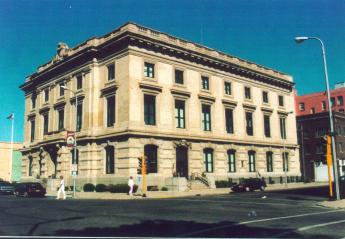The Legacy of Civil Case 3113
By Rich Stebbins
At the corner of Fourth Street and First Avenue in downtown Grand Forks, North Dakota, stands the nondescript Ronald N. Davies Federal Building and U.S. Courthouse. Few people are familiar with the legacy of the man for whom this building is named.
Through a twist of fate, then-Judge Davies issued an order in 1954 that significantly advanced the cause of civil rights and equality for Black Americans through a commitment to the law and sense of justice – changing the course of American history.
Davies was nominated to serve as a federal judge by President Dwight D. Eisenhower in August 1955. "I hope that I will have the courage to meet and discharge the responsibilities of my office," said Davies during his induction speech.
Two years later, Judge Davies was temporarily assigned to the U.S. District Court for the Eastern District of Arkansas in Little Rock to help clear backlogged cases, filling in for the presiding judge, who was ill.
One of the cases he presided over was Civil Case 3113, also known as Aaron v. Cooper. The rest of the world would come to know it as the Little Rock Nine desegregation case. Following the U.S. Supreme Court’s landmark 1954 decision in Brown v. Board of Education, which held that all public schools in the nation were to become desegregated, a group of segregationists, supported by Arkansas Governor Orval Faubus, prevented nine black students from entering Little Rock’s Central High School.
The Little Rock Nine case thrust Davies into the spotlight as a tense standoff occurred around the nation and in the courtroom. Despite the chaos surrounding the situation, Davies remained calm and resolute.
At the school, Governor Faubus called in the Arkansas National Guard to stop the nine black students from entering the building and put pressure on President Eisenhower to act.
Eisenhower issued a warning to the nation: “I will use the full power of the United States -- including whatever force may be necessary -- to prevent any obstruction of the law and carry out the orders of the federal court.”
In the courtroom, as the prosecution and the defense presented their arguments, Davies maintained his focus on applying the law despite receiving death threats and violent messages.
“It must never be thought that the court has not given careful consideration to this problem and all that it entails, but it must never be forgotten that I have a constitutional obligation from which I shall not shrink,” said Davies in recorded court testimony.
In September 1957, Davies rendered his decision in Civil Case 3113, ordering the integration of Little Rock High School. It would change the nature of public school integration in the United States, according to the University of Arkansas at Little Rock Law Review. This landmark decision was made on behalf of a few citizens, but it had a larger impact across the country as it ruled that states must follow the decisions of the U.S. Supreme Court.
Davies never surrendered his legal principles or allowed the justice system to be disrupted and weakened. He returned to North Dakota in early October 1957 and continued to serve as a Federal District Court judge until his death in 1996.
The federal building, originally built in 1906 and with several improvements over the years, was listed in the National Register of Historic Places in 1976. It was renamed the Ronald N. Davies Federal Building and U.S. Courthouse in 2002.

 U.S. General Services Administration
U.S. General Services Administration
